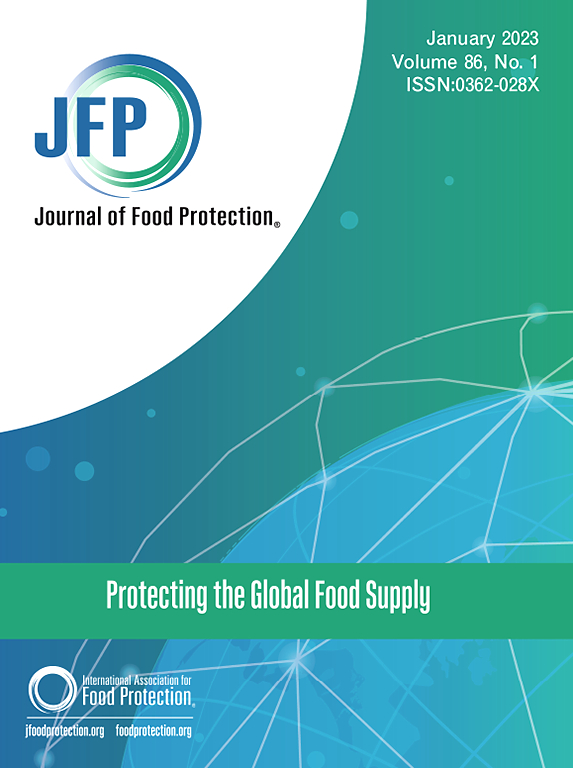意大利东北部肉类和牛奶中分离的金黄色葡萄球菌的流行和特征。
IF 2.8
4区 农林科学
Q3 BIOTECHNOLOGY & APPLIED MICROBIOLOGY
引用次数: 0
摘要
金黄色葡萄球菌是一种经常在动物源性食品中发现的致病微生物,因其容易对抗生素治疗产生耐药性而闻名。本研究旨在确定意大利原料牛奶和肉类中金黄色葡萄球菌菌株的流行情况,并评估其抗生素耐药性和生物膜产量。肉用分离菌中,41.67%对氨苄西林耐药,25%对甲氧西林耐药金黄色葡萄球菌(MRSA)耐药。牛奶中20%的分离株对庆大霉素耐药,5.71%的分离株对MRSA耐药。多药耐药菌株在肉类中的流行率(16.67%)高于牛奶(5.71%)。对大多数菌株的生物膜形成能力进行了评估(牛奶中80%,肉类中100%)。具有不同抗生素耐药谱的代表性菌株均为肠毒素基因sea、seb、sec、sed和see阴性,但具有溶血活性、高色素沉着、低细胞膜通透性、带电性和疏水性等潜在毒力因子。最后,代表性菌株与人Caco-2肠道细胞系的相互作用表明,大多数菌株具有粘附能力。我们的研究结果表明,金黄色葡萄球菌的食源性分离株对消费者构成相当大的威胁,因为它们产生毒力因子,从而增强其致病性并增加抗生素治疗失败的可能性。本文章由计算机程序翻译,如有差异,请以英文原文为准。
Prevalence and Characterization of Staphylococcus aureus Isolated from Meat and Milk in Northeastern Italy
Staphylococcus aureus is a pathogenic microorganism often found in animal-derived foods and is known for its ability to readily develop resistance to antibiotic treatments. This study was designed to determine the prevalence of S. aureus strains in raw milk and meat in Italy and to evaluate their antibiotic resistance profiles and biofilm production. Among the meat isolates, 41.67% were resistant to ampicillin, and 25% were methicillin-resistant S. aureus (MRSA). In milk, 20% of the isolates were resistant to gentamycin, while 5.71% were MRSA. The prevalence of multidrug-resistant strains was higher in meat (16.67%) compared to milk (5.71%). The biofilm formation capability was assessed in most of the isolates (80% in milk and 100% in meat). Representative strains exhibiting different antibiotic resistance profiles were all negative for the enterotoxin genes sea, seb, sec, sed, and see, but harbored potential virulence factors such as hemolytic activity, high pigmentation, low cell envelop permeability, charged and hydrophobicity. Finally, the interaction of representative strains with human Caco-2 intestinal cell line showed that most strains had an adhesion capacity. Our findings reveal that foodborne isolates of S. aureus present a considerable threat to consumers due to their production of virulence factors, which enhance their pathogenicity and increase the likelihood of antibiotic treatment failures.
求助全文
通过发布文献求助,成功后即可免费获取论文全文。
去求助
来源期刊

Journal of food protection
工程技术-生物工程与应用微生物
CiteScore
4.20
自引率
5.00%
发文量
296
审稿时长
2.5 months
期刊介绍:
The Journal of Food Protection® (JFP) is an international, monthly scientific journal in the English language published by the International Association for Food Protection (IAFP). JFP publishes research and review articles on all aspects of food protection and safety. Major emphases of JFP are placed on studies dealing with:
Tracking, detecting (including traditional, molecular, and real-time), inactivating, and controlling food-related hazards, including microorganisms (including antibiotic resistance), microbial (mycotoxins, seafood toxins) and non-microbial toxins (heavy metals, pesticides, veterinary drug residues, migrants from food packaging, and processing contaminants), allergens and pests (insects, rodents) in human food, pet food and animal feed throughout the food chain;
Microbiological food quality and traditional/novel methods to assay microbiological food quality;
Prevention of food-related hazards and food spoilage through food preservatives and thermal/non-thermal processes, including process validation;
Food fermentations and food-related probiotics;
Safe food handling practices during pre-harvest, harvest, post-harvest, distribution and consumption, including food safety education for retailers, foodservice, and consumers;
Risk assessments for food-related hazards;
Economic impact of food-related hazards, foodborne illness, food loss, food spoilage, and adulterated foods;
Food fraud, food authentication, food defense, and foodborne disease outbreak investigations.
 求助内容:
求助内容: 应助结果提醒方式:
应助结果提醒方式:


